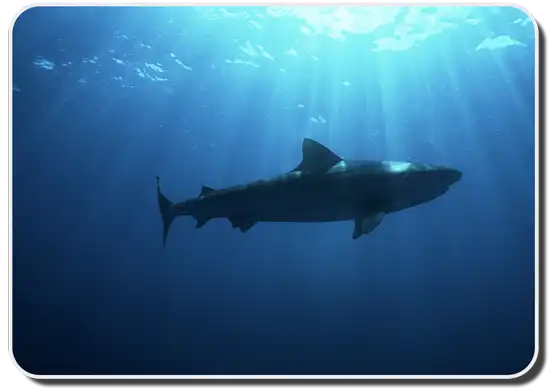Dusky sharks are a requiem shark known for their slow growth rate, taking around 20 years to reach adulthood. They are also known for their seasonal migrations, for which they form temporary schools, disbanding and becoming solitary once they reach their destination.
Dusky Shark Scientific Classification |
|
| Kingdom | Animalia |
| Phylum | Chordata |
| Class | Chondrichthyes |
| Order | Carcharhiniformes |
| Family | Carcharhinidae |
| Genus | Carcharhinus |
| Scientific Name | C. obscurus |
Description
This shark is 10 ft long and weighs 350–400 lb, making it one of the largest members of its genus. The heaviest recorded specimen weighed 765 lb and was 14 ft long.
 Their bodies are streamlined and slender, with a rounded snout, barely developed nostrils, and medium-sized eyes with third eyelids. Inside their short mouth, they have 14-15 rows on both jaws, with the teeth in the upper jaw being broad and triangular, and those on the lower one are narrower and more serrated. The five gill slits of these sharks are long.
Their bodies are streamlined and slender, with a rounded snout, barely developed nostrils, and medium-sized eyes with third eyelids. Inside their short mouth, they have 14-15 rows on both jaws, with the teeth in the upper jaw being broad and triangular, and those on the lower one are narrower and more serrated. The five gill slits of these sharks are long.
The sickle-shaped pectoral fins are around 1/5th of the total length of the shark’s body. Their first dorsal fin is moderately sized, while the second one is much smaller and opposite to the anal fin. A dorsal ridge is present between the two dorsal fins. They have a large caudal fin.
Where do they live
Map Of The Dusky Shark’s Habitat

These sharks are found throughout the Atlantic, Pacific, and Indian oceans. In the eastern Atlantic, the dusky shark lives in Cape Verde, the Canary Islands, Senegal, Sierra Leone, and the western and central Mediterranean Sea, while in the Indian Ocean, they are found in Madagascar, Mozambique, and South Africa, with reports of specimens in the Arabian Sea, the Bay of Bengal, and the Red Sea. In the Pacific, they are found in Australia, the Gulf of California, Japan, mainland China, New Caledonia, northern Chile, Revillagigedo, southern California, Taiwan, and Vietnam.
Dusky sharks live from the surf zone to the continental shelf and adjacent oceanic waters. They prefer temperatures of 66–82 °F and avoid places with low salt levels like estuaries.
Behavior
Dietary
As generalist feeders, their diet includes pelagic fishes like anchovies and tuna, demersal fishes like eels and porgies, reef fishes like barracudas, and groupers, cartilaginous fishes like thresher sharks and skates, and invertebrates like cephalopods and barnacles. They will even, on rare occasions, feed on sea turtles, waste, and carrion.
Predatory
These sharks have the strongest bite force among all modern sharks, exerting 130 lb over a 0.0031 in2 area at the tip of a tooth.
Migratory
They are a nomadic species and migrate over 2000 miles, with the adults swimming longer distances than the juveniles. The migratory pattern of adults appears to be seasonal, heading northward during the warmer summer months and returning south during the winter. The immature sharks follow a similar way, staying in the surf zone during spring and summer and traveling to offshore waters in the fall and winter. They eventually meet up with the adults when older via as-of-yet-to-be specified routes.

Reproductive
The dusky shark is viviparous similar to other requiem sharks. They mate during the spring, with the females storing sperm from several males to fertilize their eggs later. After going through a gestation period of around two years, she gives birth to a litter of 3-16 pups in places with shallow waters like lagoons. There is a one-year break between each pregnancy.
Juveniles reach sexual maturity at various ages depending on their location, but the range appears to be 18-32. On average, their lifespan is 40–50 years.
Adaptations
Like other sharks, they have sharp teeth for holding and tearing flesh and a streamlined body that helps them swim efficiently.
Interactions with humans
It is difficult to ascertain how dangerous this shark is to humans, with attacks recorded by them most likely being from Galapagos sharks that closely resemble the dusky shark. While this shark is large, whether or not that translates to violent behavior towards humans has not yet been determined.
As per the IUCN, the dusky shark is “Endangered” or “EN”. The main reason is overfishing combined with a low reproductive rate. However, due to its migratory nature, it has been hard to pinpoint the exact population numbers.
